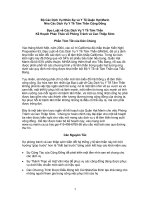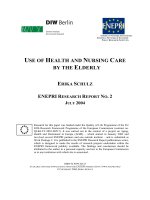Pilot of the department of health medical examiner
Bạn đang xem bản rút gọn của tài liệu. Xem và tải ngay bản đầy đủ của tài liệu tại đây (79.04 KB, 2 trang )
Pilot of the Department of
Health medical examiner
Sheffield was the first pilot site for the Department of Health medical examiner service. The
service covers all Sheffield’s acute hospitals and a third of its general practices. Since the
pilot started in March 2008, the medical examiner has reviewed over 25,000 cases.
Supported by two clinically trained officers (a biomedical scientist and a senior nurse), two
medical examiners review all deaths within 24 hours of notification, including those that
need to be referred to a coroner. They seek answers to three questions:
1. What did the person die from? (ensuring accuracy of cause of death on the
medical certificate)
2. Does this case need to be reported to a coroner? (ensuring timely, accurate
referral)
3. Are there any clinical governance concerns? (ensuring the relevant authority is
notified).
They do this by following three mandatory steps:
1. proportionate review of medical records
2. interaction with the attending doctor(s)
3. interaction with those who have been bereaved.
Each of these steps is important but the interaction with people who have been bereaved is
especially so. For cases not reported to the coroner, contact with bereaved people is made
by telephone as soon as possible after the medical certificate is completed. This is done
sensitively and is an opportunity to ask them if they have any concerns about the care
given and, if they do, consider the need for referral for further investigation.
The medical examiner does not investigate; their role is to detect and pass on – both for
individual cases and in a surveillance capacity that includes the opportunity to escalate
repeated concerns with the relevant authority.
Outcomes
The medical examiner office has performed consistent and timely reviews with the views of
bereaved people always considered. A recent review of data based on deaths since the
pilot started in 2008 found:
•
•
3,875 cases had been reviewed
possible adverse harm was detected in 10.5% (n = 405) of all deaths reviewed
1 | > Pilot of the Department of Health medical examiner
•
•
in around half of these cases (n = 217), adverse harm would not have been
detected at this early stage but for the medical examiner’s involvement
family concerns were raised in 2.3% of cases (n = 81); these could not have been
picked up from the records alone in 26 cases.
Challenges and solutions
•
Overcoming consultants’ initial suspicion about someone else independently
reviewing their cases.
•
Providing a service for urgent release – for example, for faith reasons or
transplantation. This was achieved by having an on-call medical examiner and
remote secure email.
Views of a relative
A relative of an 86-year-old woman with advanced cancer who died of pneumonia was
concerned about communication on the ward. This concern was referred to the medical
examiner office. The relative spoke to a medical examiner and later said: “Thank you for
your call earlier, I would like to say that I really appreciated your call. You answered all the
questions that I had. You were professional and very sensitive… speaking to you today has
reinstated my faith in the system.”
Learning points
•
An independent medical examiner can provide a reliable ‘filter’ for
identifying deaths that merit further review.
•
This system engages bereaved relatives, and the coroner if needed,
at a very early stage.
Further information
Please contact: Dr Alan Fletcher, Lead Medical Examiner,
0300 123 2257
improvement.nhs.uk
© NHS Improvement December 2017
2 | > Pilot of the Department of Health medical examiner









